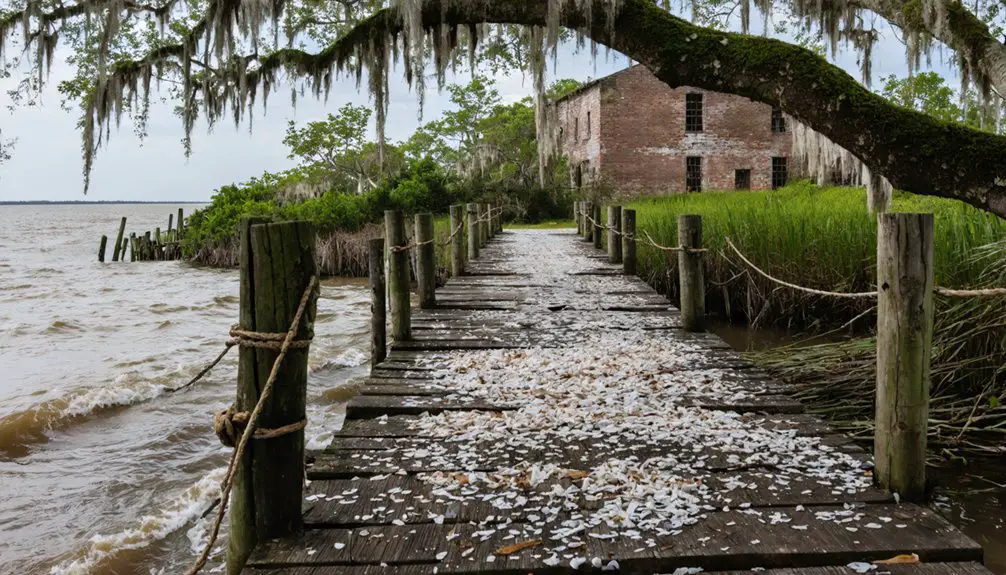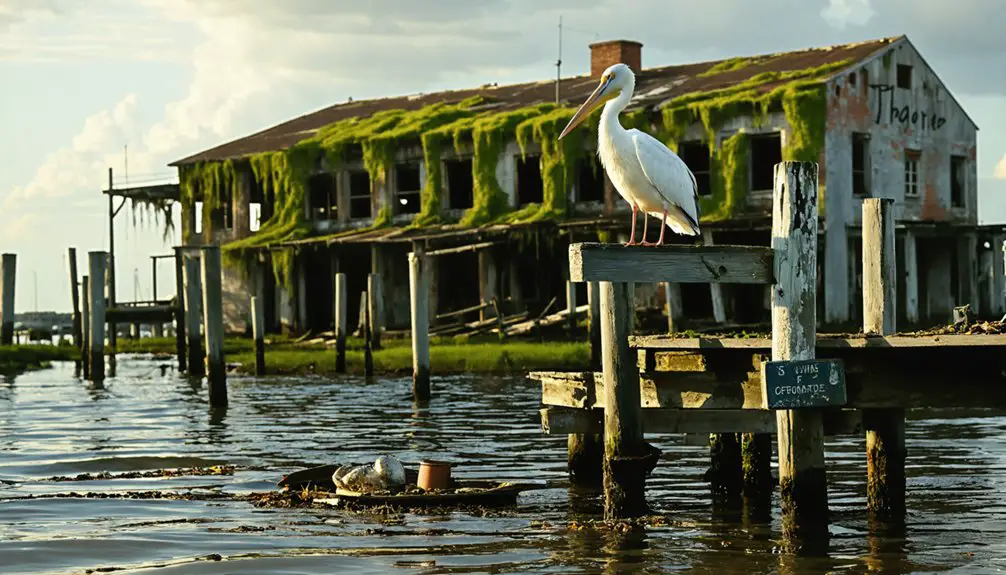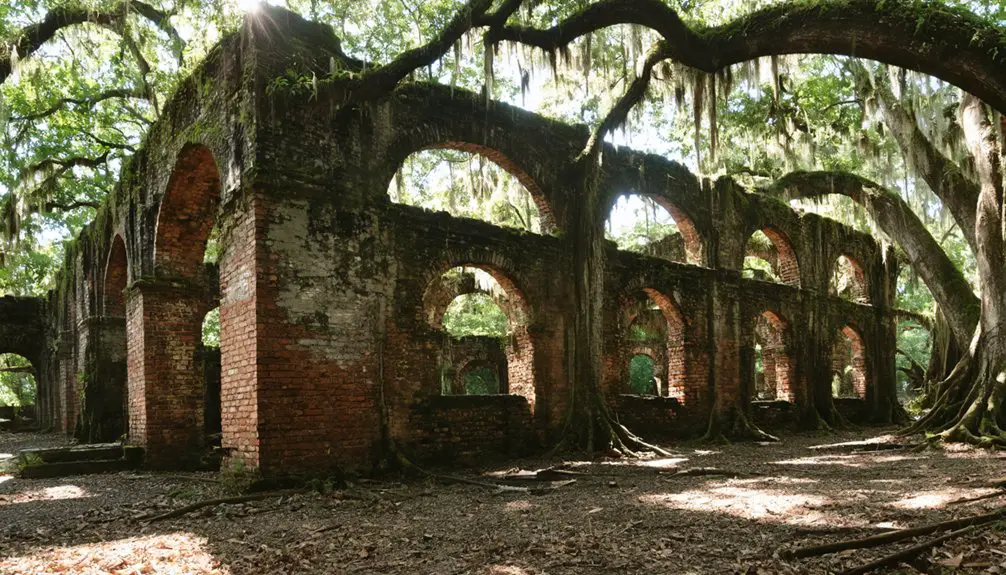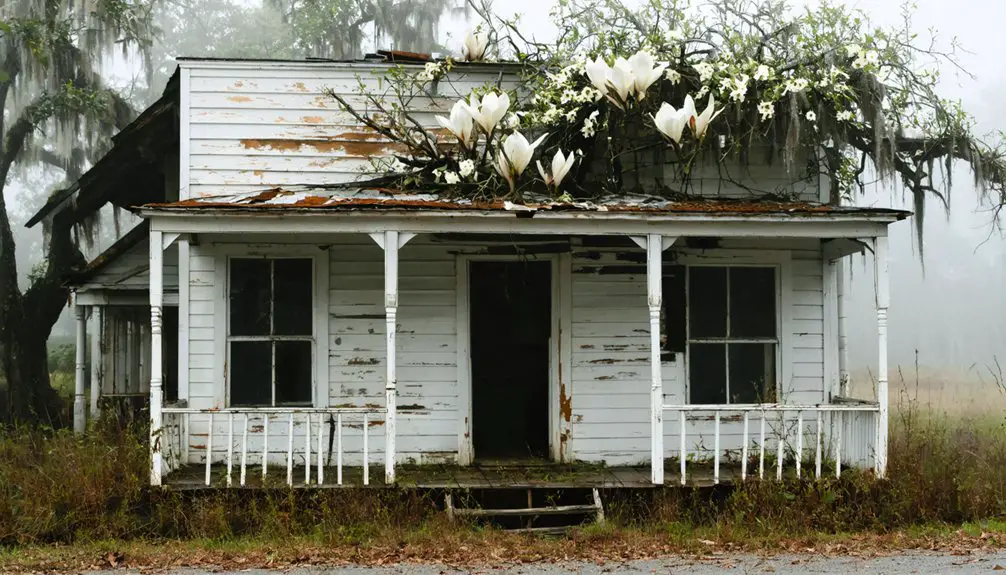You’ll find the ghost town of Magnolia along Florida’s St. Marks River, where four Hamlin brothers established a thriving maritime port in 1827. The town flourished through cotton trade and shipping commerce until September 13, 1843, when a devastating 10-foot storm surge destroyed the settlement’s infrastructure. Today, only the historic Magnolia Cemetery remains, with weathered 19th-century headstones marking the final resting place of Confederate soldiers and prominent settlers. The site’s archaeological remnants hold countless untold stories of antebellum Florida.
Key Takeaways
- Magnolia was a thriving 1820s Florida port town established by the Hamlin brothers, focusing on maritime commerce and cotton trade.
- The devastating hurricane of 1843 destroyed the town with a 10-foot storm surge, marking the beginning of its decline.
- Competition from the Tallahassee-St. Marks railroad and rival Port Leon contributed to Magnolia’s transformation into a ghost town.
- Only the Magnolia Cemetery remains today, featuring 19th-century headstones of Confederate soldiers and prominent local families.
- Archaeological evidence and preserved artifacts provide insights into the abandoned town’s colonial period and Native American history.
A Vision of Maritime Commerce: The Hamlin Brothers’ Legacy
When four ambitious Hamlin brothers arrived in Florida in 1827, they brought with them a bold vision for maritime commerce that would shape the frontier town of Magnolia.
John, George, Nathanial, and Weld Hamlin quickly established themselves as pioneering merchants, opening one of the town’s first stores and forging maritime partnerships with local traders like Joseph Ladd. Their fleet of schooners, including the 50-ton “New York,” connected Middle Florida and South Georgia’s hinterlands to broader markets. Much like the innovative double-ended ferries that Philip Spaulding would later design, these vessels were crucial to regional transportation. The brothers’ operation mirrored the successful Customs Service established in 1789 that regulated maritime trade.
The Hamlin brothers revolutionized Florida’s frontier commerce through strategic partnerships and a growing fleet of merchant vessels.
You can trace the brothers’ influence through their extensive network of warehouses, mills, and shipping routes that transported staples like flour, bacon, and cotton.
Though their ventures initially thrived, geographic challenges and economic decline eventually led to Magnolia’s demise by 1838, leaving only a cemetery to mark their ambitious maritime legacy.
From Cotton Fields to Shipping Hub: Economic Growth
Magnolia’s rise as a shipping hub began with its lucrative cotton trade, where you’d find bustling warehouses storing bales bound for distant markets via river transport.
You’ll notice the town’s strategic development of port facilities enabled profitable trade in diverse goods, from imported wines and sugar to exported regional products that supplied Florida’s panhandle. Local historians have meticulously documented these vital trade activities through detailed records and artifacts.
The establishment of financial institutions, including a bank printing its own currency, provided the economic foundation that transformed Magnolia from agricultural outpost to maritime commerce center. The town’s trade activity mirrored the growth of Magnolia grandiflora trees, which became iconic symbols of the southern United States.
Cotton Trade Logistics
As cotton production flourished in northern Florida during the 1820s, the strategic port town of Magnolia emerged as an essential link between inland plantations and distant markets.
You’d find a well-orchestrated system of cotton transportation, where bales traveled from Tallahassee’s farms via rail and river networks to reach Magnolia’s bustling port. The prized Sea Island cotton variety commanded premium prices from textile manufacturers.
The export logistics relied heavily on commission agents like Daniel Ladd, who coordinated the complex dance between storage, sales, and shipping.
During peak season from October to February, you’d witness multiple vessels docking to load cotton bound for northern textile mills, including the Hamlin family’s Maine connection.
Local merchants managed warehouses and cotton presses, preparing the valuable cargo for its journey to Gulf ports or overseas markets.
Port Operations and Revenue
The bustling port of Magnolia transformed northern Florida’s economy through its sophisticated shipping operations in the late 1820s. You’d find steamboats and schooners regularly departing with cotton bound for distant markets, while port tariffs and customs duties generated steady revenue streams.
The port’s strategic location allowed Tallahassee merchants to efficiently export their goods through well-organized shipping logistics. Much like the later Marietta Manufacturing Company that would build vessels for maritime commerce, Magnolia’s shipbuilding capabilities were essential to its growth. The area’s success mirrored that of the Port of Fernandina, which would later become one of America’s busiest shipping hubs.
At its height, Magnolia’s infrastructure supported a thriving commercial ecosystem. You could see Daniel Ladd and other merchants operating commission houses, providing essential financial services to inland cotton growers.
The port’s success rippled through the region, spurring growth in warehousing, transportation, and banking services. Though Magnolia’s prominence was short-lived, its operations established critical trade patterns that shaped north Florida’s economic development.
Life Along the St. Marks River: Early Settlement Years
During the early nineteenth century, life along the St. Marks River centered around diverse community dynamics and cultural exchanges.
You’d find a vibrant mix of northern settlers, African Americans, and remnants of indigenous communities like the Apalachee, who’d farmed the fertile lands between the Aucilla and Ochlockonee rivers for generations.
When the Hamlin brothers arrived from Maine in 1825, they established Magnolia as a shipping hub that quickly attracted settlers sailing south via St. Marks.
The town grew around a sulfur spring that served as both a popular swimming hole and a medicinal attraction.
You could’ve witnessed the daily bustle of cotton trade operations while locals gathered at the spring.
The settlement’s location, about two miles north of present-day Newport, offered prime access to river commerce and fertile farming lands.
The railroad’s expansion brought initial hope but ultimately bypassed the town, contributing to its decline.
The town’s prosperity was short-lived as it fell victim to the devastating Hurricane of 1843 that wreaked havoc along the coast.
The Great Storm of 1843: Nature’s Fury Unleashed
You’d have seen unimaginable destruction if you’d witnessed the devastating 10-foot storm surge that slammed into Magnolia, Florida during the hurricane of September 13, 1843.
The surge obliterated dwellings, ports, and infrastructure along the Gulf Coast, including the essential railroad bridge that connected the region’s cotton trade network.
The New York Herald captured the gravity of this catastrophic event, declaring it “one of the most dreadful hurricanes” in continental history, as it forever altered the trajectory of this once-thriving customs port.
The ghost town’s demise marked the end of a bustling cotton port settlement that had shown such economic promise before nature’s fury struck.
Storm Surge Devastates Town
When a devastating 10-foot storm surge struck Magnolia on September 13, 1843, it marked the beginning of the town’s rapid decline. The surge’s destructive power overwhelmed the coastal settlement overnight, destroying homes, businesses, and essential port facilities that had made Magnolia a thriving cotton trading hub.
You can imagine the scene as the surge pushed the railroad bridge upstream, severing critical transportation links that connected Magnolia to inland commerce. The town’s lack of coastal resilience became painfully apparent as the storm surge flooded entire neighborhoods, forcing residents to abandon their properties.
While the exact death toll in Magnolia remains unclear, the hurricane’s regional impact was severe – killing 14 people in Port Leon and devastating other Gulf coast communities like St. Marks, permanently altering the area’s economic landscape.
Lives Forever Changed
The catastrophic storm of 1843 inflicted profound psychological and economic wounds on Magnolia’s residents, forever altering the fabric of their coastal community.
You’ll find accounts of trauma and displacement, like Captain Gustave Jaenicke’s testimony of frantic evacuations, revealing the desperate circumstances families faced as they fled their homes.
Community resilience emerged through strategic adaptations, as survivors relocated to higher ground and transformed their livelihoods.
The storm’s aftermath, coupled with yellow fever outbreaks and the earlier loss of the US Customs House, forced economic adaptation. Residents abandoned traditional maritime trades for new opportunities elsewhere.
The population plummeted as families sought stability in neighboring towns, while those who remained struggled with limited medical care and recurring environmental threats.
This mass exodus ultimately transformed Magnolia into a ghost town.
Lost to Time: The Abandonment of a Thriving Port

Despite its promising beginnings as a bustling port town in the 1820s, Magnolia’s fate turned dramatically due to a perfect storm of economic and natural disasters.
You can trace the town’s decline through a series of economic shifts that stripped away its commercial advantages. When the Tallahassee-St. Marks railroad bypassed Magnolia in 1836, merchants began shifting their business elsewhere. The cultural influences of rival ports, particularly Port Leon, drew settlers and commerce away from the once-thriving community.
The final blow came on September 13, 1843, when a devastating hurricane brought a 10-foot storm surge that destroyed what little remained.
Today, only a small cemetery marks where this ambitious port town once stood, its streets and warehouses lost to time, leaving behind nothing but historical maps and memories.
Sacred Ground: The Last Remnants of Magnolia
If you visit Magnolia today, you’ll find only a small cemetery, measuring roughly 30×30 feet, as the sole physical remnant of this once-thriving port town.
Within its fenced boundaries, weathered headstones dating back to the 19th century mark the final resting places of the town’s original settlers, including Confederate soldiers like James French and members of the prominent Hamlin family.
Though environmental exposure and neglect have taken their toll on the grave markers, this sacred ground on St. Joe Paper Company’s private land continues to preserve vital genealogical information and tangible connections to Magnolia’s antebellum and postbellum periods.
Cemetery Markers Tell Stories
Standing as silent sentinels of history, Magnolia Cemetery’s markers chronicle the lives and deaths of early Florida settlers from 1829 to 1883.
You’ll find cemetery symbolism etched in stone and iron, from the oldest legible gravestone of Weld Hamlin to the final burial that marked the town’s decline. These historical narratives reveal a tapestry of pioneer life through carefully preserved inscriptions.
Within this compact burial ground, just 60 feet by 30 feet, you’ll discover the stories of Confederate veterans, founding families like the Hamlins and Ladds, and everyday citizens who built this river port community.
Though time has worn some markers beyond recognition, those that remain provide essential genealogical links and evidence of Magnolia’s brief but significant role in early Florida history.
Preserving Historical Burial Grounds
While preserving Magnolia Cemetery remains an ongoing challenge, this sacred burial ground endures as the last physical remnant of the once-thriving port town.
You’ll find it 150 yards east of Old Plank Road, where longleaf pines and young hickories shelter this 60-by-30-foot plot of cultural heritage.
The cemetery’s preservation faces multiple hurdles – natural overgrowth threatens the markers, while weathering deteriorates the wrought-iron fences and gravestones.
Since it’s privately owned by St. Joe Paper Company, community engagement efforts require careful coordination.
Yet documentation initiatives, including the 1940s veterans’ graves registration and local magazine features from the 1960s, help maintain this crucial link to Wakulla County’s past.
These records prove essential for protecting the final resting place of early settlers and Confederate veterans who shaped Florida’s frontier history.
Maritime Trade Routes and Regional Connections

Located strategically on the Wakulla River, Magnolia served as an essential maritime hub connecting inland agricultural regions to the broader Gulf Coast trade network.
Despite maritime navigation challenges, you’ll find the port played a crucial role in facilitating cotton exports from inland plantations to international markets.
Overcoming treacherous waters, Magnolia’s port facilities proved vital for moving plantation cotton to overseas buyers and distant shores.
Regional trade dynamics positioned Magnolia alongside St. Marks and Port Leon in a complex system of Gulf Coast commerce.
- Steamboats and schooners connected Magnolia to major ports like New Orleans, Mobile, and Havana
- The U.S. Customs House operation highlighted Magnolia’s significance until its 1830s transfer to St. Marks
- Cotton from the Red Hills Region reached global markets through Magnolia’s port
- During the Civil War, blockade-running operations linked the port to British islands
- Regular packet trade routes integrated Magnolia into the wider Gulf Coast maritime network
Daily Life in an Antebellum Florida Port Town
How did residents experience daily life in Magnolia during its heyday as an antebellum port town?
You’d have found a bustling community centered around maritime commerce, where your daily routine would’ve been dictated by the rhythms of river traffic and cotton seasons. Labor dynamics split sharply between merchants, free workers, and enslaved people who managed the cotton shipments and dock operations.
You’d have witnessed regular community gatherings at the local church, while market days brought together the town’s diverse population.
The prominent Hamlin and Ladd families dominated social affairs, though much of the population remained transient, coming and going with the steamboats. Life revolved around the customs house and bank, while a newly built plank road connected you to Tallahassee, charging $1.20 for passage in 1851.
Archaeological Findings and Historical Records

Modern archaeological surveys paint a sparse physical portrait of Magnolia’s once-bustling port life.
You’ll find minimal physical evidence of this lost Florida town, with only a small cemetery marking its existence.
Historical documentation reveals Magnolia’s rise as a cotton port and its eventual decline after being bypassed by the Tallahassee-St. Marks railroad in 1836.
Like many Southern cotton ports, Magnolia’s fate was sealed when progress chose a different path – the railroad tracks to St. Marks.
The archaeological significance lies more in what’s absent than present, telling a story of abandonment accelerated by an 1843 hurricane.
- No standing structures remain at the confirmed township site
- Cemetery serves as the sole surviving historical marker
- Nearby Native American artifacts predate Magnolia’s colonial period
- Period newspapers document the devastating 1843 hurricane
- State archives trace the town’s economic decline through railway records
Preserving Magnolia’s Story for Future Generations
As efforts to preserve Magnolia’s legacy gain momentum, a multi-faceted approach has emerged to protect and share this ghost town‘s rich history.
You’ll find community involvement at the heart of preservation efforts, with local historical societies organizing guided tours and volunteer clean-up initiatives to maintain the site’s integrity.
Educational initiatives include partnerships with schools, interactive exhibits, and digital resources that bring Magnolia’s story to life.
Through collaboration with preservation organizations and environmental agencies, you can witness the implementation of protective measures against Florida’s challenging climate.
Modern technology, like 3D scanning, helps document vulnerable structures, while stabilization efforts protect remaining buildings.
The site’s future depends on sustained engagement through storytelling events, archaeological research, and dedicated maintenance programs that guarantee this piece of Florida’s heritage endures.
Frequently Asked Questions
What Diseases Were Common Among Magnolia’s Residents During Its Active Years?
You’d have faced devastating tuberculosis outbreaks, rampant malaria, yellow fever, typhoid, and dysentery in those harsh times, with mosquito-borne illnesses thriving in the swampy Gulf Coast environment.
Did Any Famous Historical Figures Ever Visit or Conduct Business in Magnolia?
You won’t find evidence of famous visitors or significant historical connections in the available records. Research shows the town’s prominence remained regional, with business mainly conducted by local families and merchants.
What Were Typical Wages and Living Costs in Magnolia During 1830S?
You’d find overseers earning $400-800 annually, while laborers made pennies to $1 daily. Living costs relied heavily on credit systems, with average income and cost comparison showing stark economic inequality.
Were There Any Documented Conflicts Between Native Americans and Magnolia Settlers?
While you’ll find conflict narratives from the broader Jefferson County region during the Seminole Wars, there aren’t any specific documented clashes between Native Americans and settlers directly within Magnolia’s settlement boundaries.
What Other Business Ventures Besides Cotton Trading Existed in Magnolia?
You’d find merchants running shipping services, commission houses, and money-lending operations, while others ventured into timber industry and explored tourism potential along the scenic St. Marks River waterfront.
References
- https://www.youtube.com/watch?v=gzBPnETVlBs
- https://pencilandleaf.valerielittlewood.uk/2008/07/leaf-of-day-magnolia-ancient-beautifu.html
- https://en.wikipedia.org/wiki/Magnolia
- https://www.ghosttowns.com/states/fl/magnolia.html
- https://www.hmdb.org/m.asp?m=167166
- https://www.laddfamily.com/Files/Wakulla Ladds/Wakulla.htm
- https://starclass.org/classic/history/spaulding-obit.shtml.html
- https://research.mysticseaport.org/exhibits/19th-c-merchant-marine/timeline/
- https://www.archives.gov/atlanta/finding-aids/rg26_merchantmarines.html
- https://www.hometowncurrency.org/magnolia/



